Learn how to make kimchi at home with this spicy kimchi recipe, including ingredients swaps and variations so you can make it your own way. I make mine with an easy wet brine and lots of extra spices.
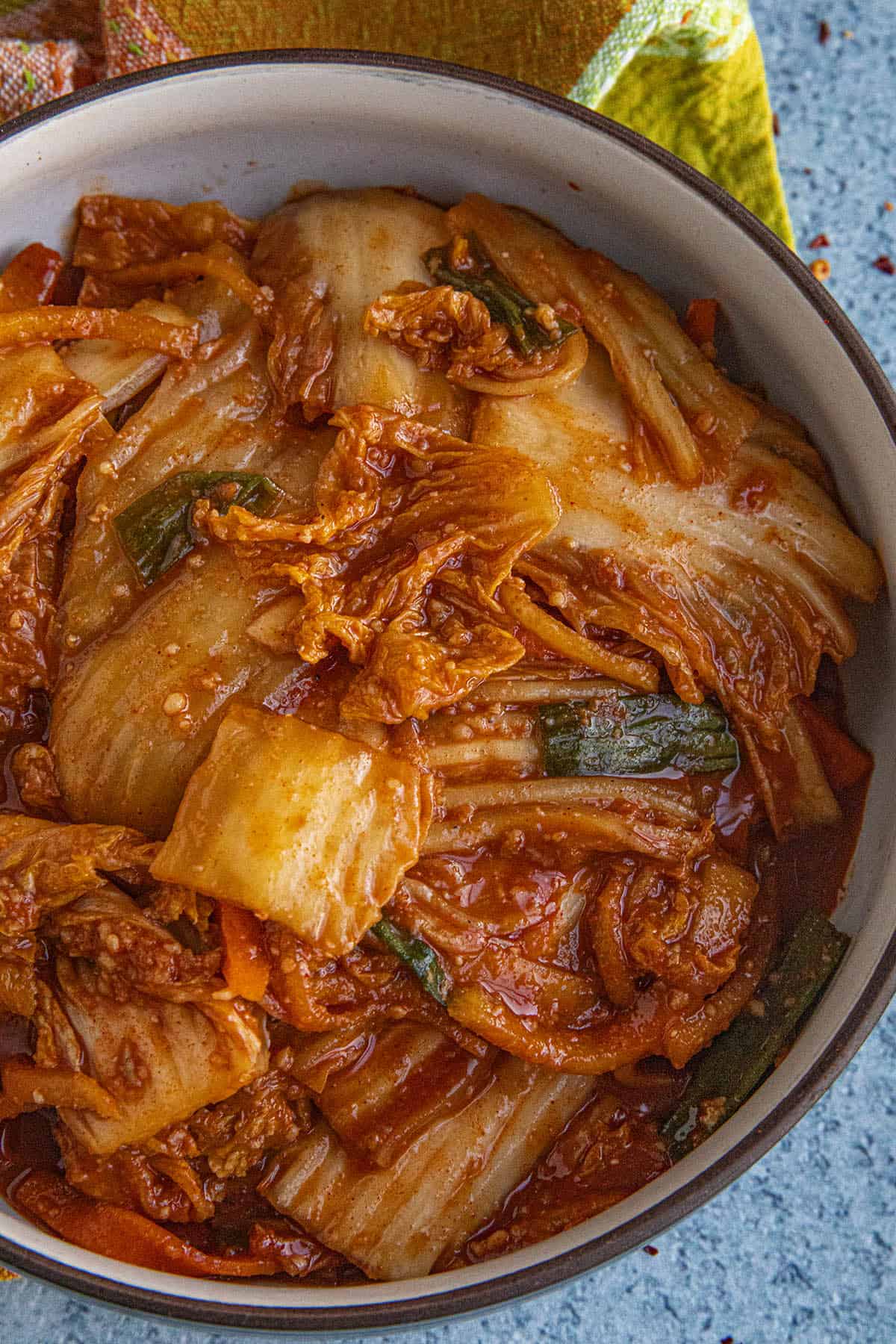
How to Make Kimchi (Kimchi Recipe)
We're making Homemade Kimchi in the Chili Pepper Madness kitchen today, my friends. If you're spicy food lover, I'm certain that kimchi is already on your radar.
Kimchi is a Korean dish of spicy fermented vegetables, and extremely significant to Korean cuisine. It is consumed in many ways throughout Korea, tossed into fried rice dishes, ramen type dishes, served up as the star of the meal or nibbled on as a simple, healthy snack.
Napa cabbage is more commonly used, though it can be made with many other vegetables. The process involves fermentation, which is the break down of foods by lactic acid bacteria in a salt brine.
The result is healthier, well preserved food with more vitamins and a characteristic funk factor.
This particular version is the more popular Baechu Kimchi, or Napa Cabbage Kimchi, and we love it. It's definitely a spicy kimchi, as I include some extra spice, as well as extra umami because we just love it that way.
I also use a wet brine method, as opposed to a dry brine method, because it is easier to do and more fool-proof. Some people prefer the dry brine method, which is totally fine, but I always get great results this way.
Let's talk about how to make kimchi, shall we?
Kimchi Ingredients Needed
- FOR THE CABBAGE BRINE
- Unchlorinated Water. For brining the cabbage. Filtered or bottled water are good.
- Salt. Kosher salt or sea salt.
- Napa Cabbage. Use 1 large head, about 3 pounds.
- TO MAKE THE KIMCHI
- Extra Vegetables and Fruit. Carrots, scallions or green onions, daikon radish or turnip, fresh garlic and ginger. Also, an Asian pear for sugar/sweet.
- Glutinous Rice Flour. This not only helps the spicy kimchi sauce stick to the cabbage and vegetables, but also provides some sugars for fermenting.
- Gochugaru. Gochugaru is a coarsely ground Korean chili powder, or red pepper flakes, that add lots of flavor and spice it up. It is best to use authentic gochugaru, not a substitute.
- Umami. I use fish sauce and salted shrimp (saeujeot) and miso paste. As an alternative, use shrimp paste, or chopped dried shrimp, soy sauce, or other umami ingredients. See the recipe notes below.
How to Make Kimchi - the Recipe Method
BRINE THE CABBAGE
Make the Brine. Whisk together the unchlorinated cold water and sprinkle salt in a large bowl.
Slice the Cabbage. Slice off the root end of the cabbage. Slice the cabbage into quarters and submerge them in the brine. Use a plate or other small weights to keep the cabbage completely submerged.
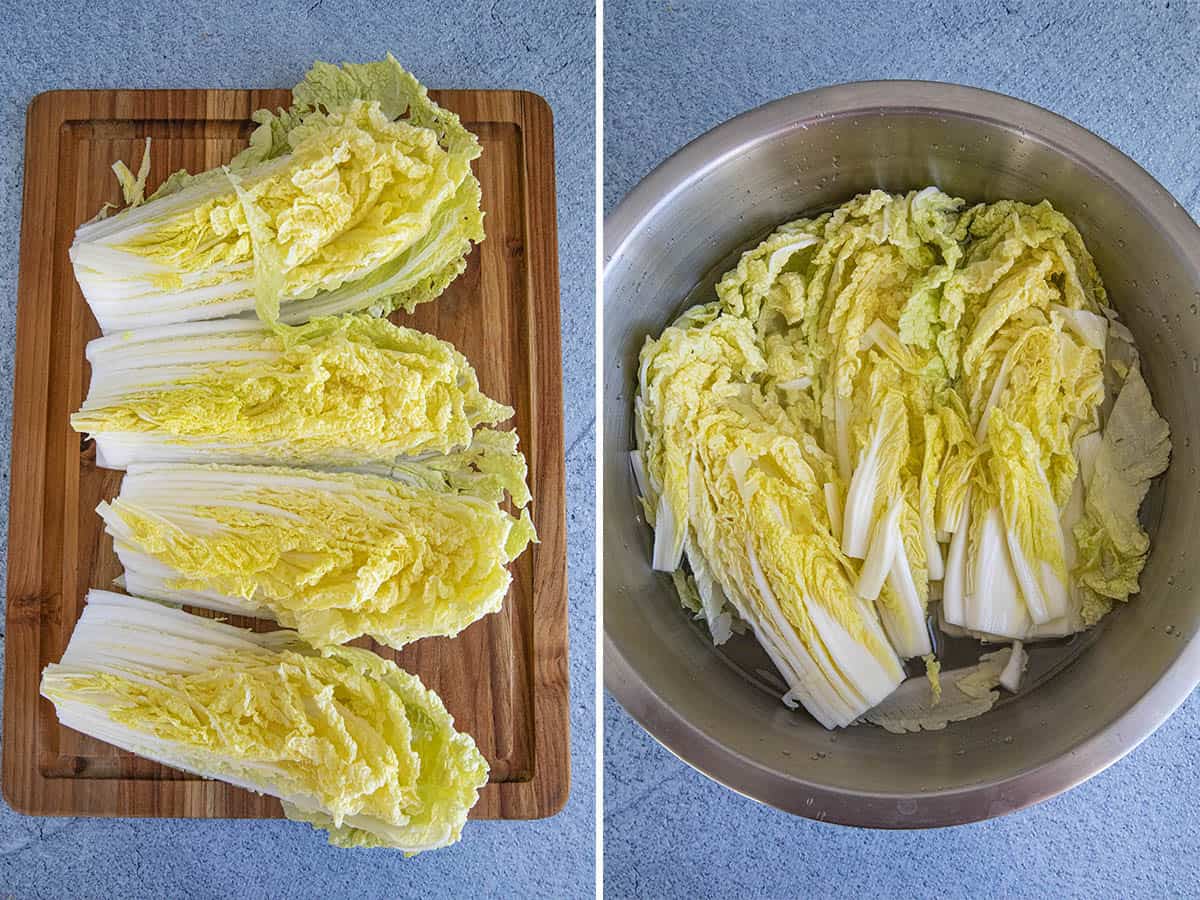
Brine the Cabbage. Set aside for 8-12 hours at room temperature.
Rinse and Chop the Cabbage. Set the cabbage into a colander and drain the brine. Rinse the cabbage and squeeze out excess water using your hands. Chop the cabbage into 1 inch pieces (if desired, or leave the pieces whole).
PREP THE VEGETABLES
Slice and Combine the Vegetables. Slice the the carrot, scallions, radish or turnip, and Asian pear into thin slices or matchsticks. Chop the garlic and ginger.
Add them all to a large bowl along with the chopped cabbage. Toss to combine.
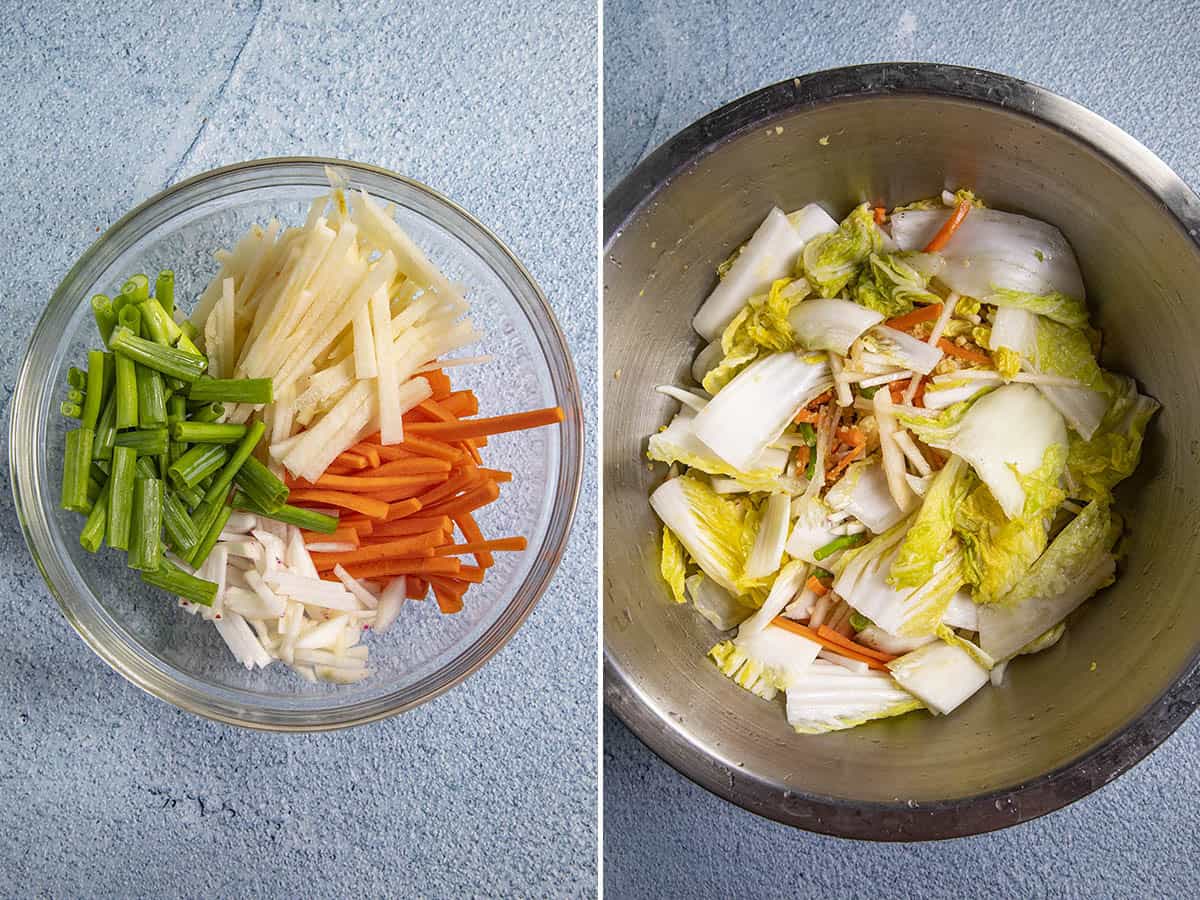
MAKE THE KIMCHI SAUCE
Glutinous Rice Flower. Add the rice flour and 1 cup water to a sauce pan. Heat to a simmer, then whisk for 3-4 minutes until smooth and the mixture forms a smooth, loose paste.
Korean Chili Flakes (Gochugaru). Remove from heat and stir in the gochugaru. The chili flakes will bloom as the mixture cools.
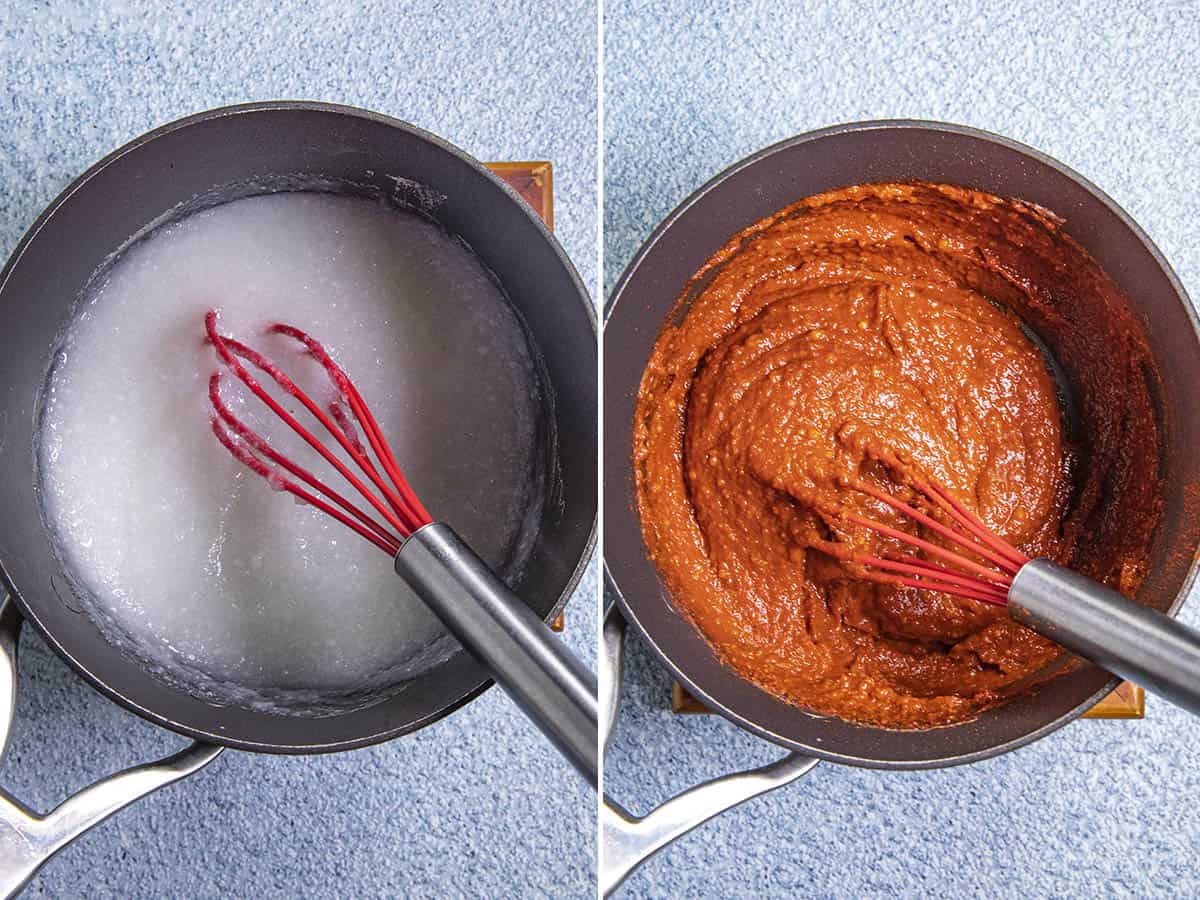
Add the Umami. Stir in the fish sauce, salted shrimp, and miso paste (or your other umami alternatives).
MAKE THE KIMCHI
Mix with the Cabbage and Vegetables. Pour the mixture into the cabbage leaves and vegetables. With your hands, rub the gochugaru mixture into the vegetables, covering them as completely as possible. Be thorough.
Really get in there with your hands!
Taste and Adjust. Taste and adjust for salt or any other desired seasonings. Need more chili flakes? More fish sauce? Go for it!
Pack into Jars. Pack it all into a large mason jar (or several). You can use other vessels, like a fermentation crock. Press the contents down and weigh it down with glass fermentation weights (or use a plastic bag filled with water).
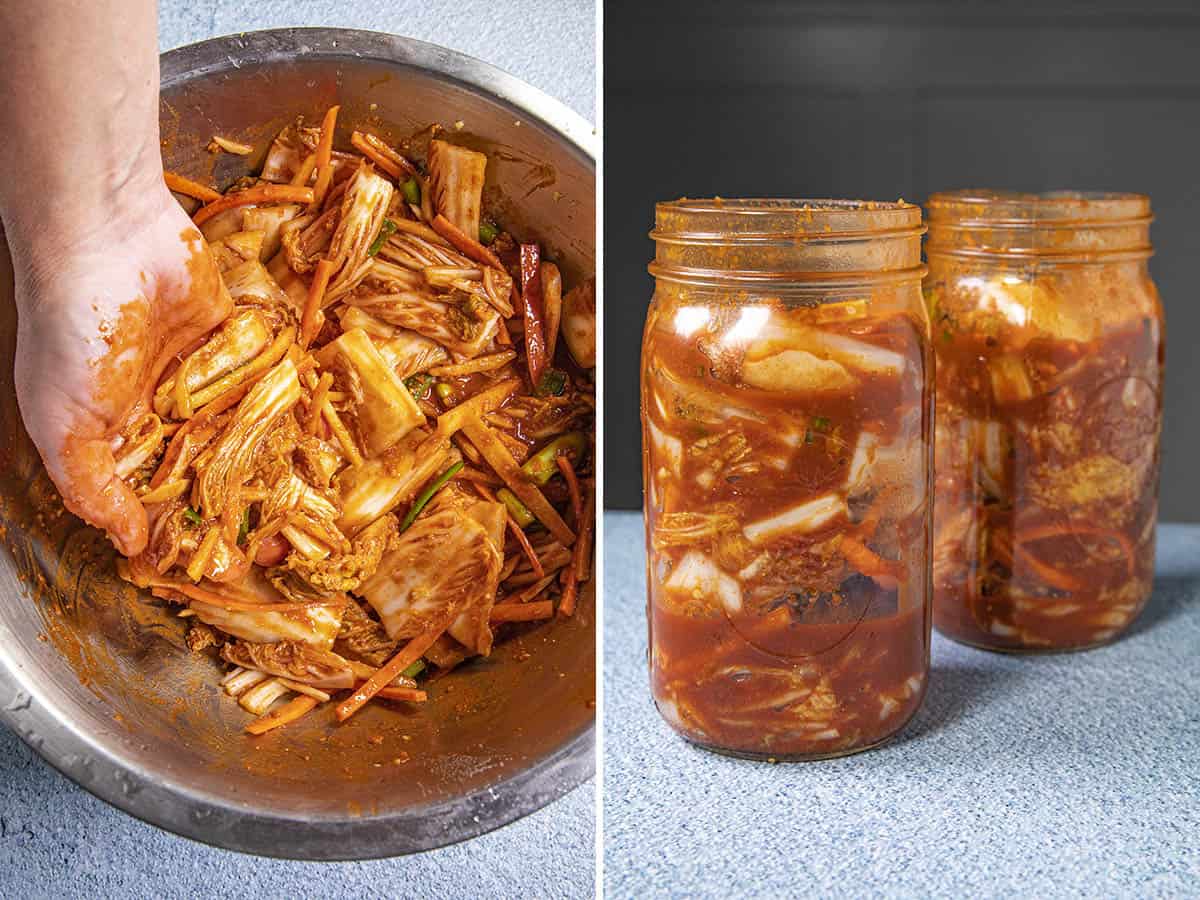
Cover for Fermentation. Cover with a fermentation airlock lid, or use fermentation membranes (see notes). If you don’t have such lid options, use a 2-piece lid, but don’t screw it down, just set it on top.
This is to allow any gases to escape while fermenting.

Ferment the Kimchi. Set aside away from any sunlit areas and ferment for 1-3 days at room temperature (you CAN ferment longer if you’d like – see RECIPE NOTES on fermentation times).
Moisture should release from the jar, so press the kimchi down if needed to keep it below the liquid. Gases should escape via the fermentation membrane, or just loosen the lid to let any gas build up out.
Refrigerate. Set into the refrigerator and let sit for 1 week to let the flavors mingle. You can enjoy it right away, but it is better to wait.
The fermenting kimchi will continue to ferment slowly in the fridge.
Boom! Done! Your kimchi is ready to go. Super curious how you plan to use your fermented cabbage once it's ready. And how spicy you made it!
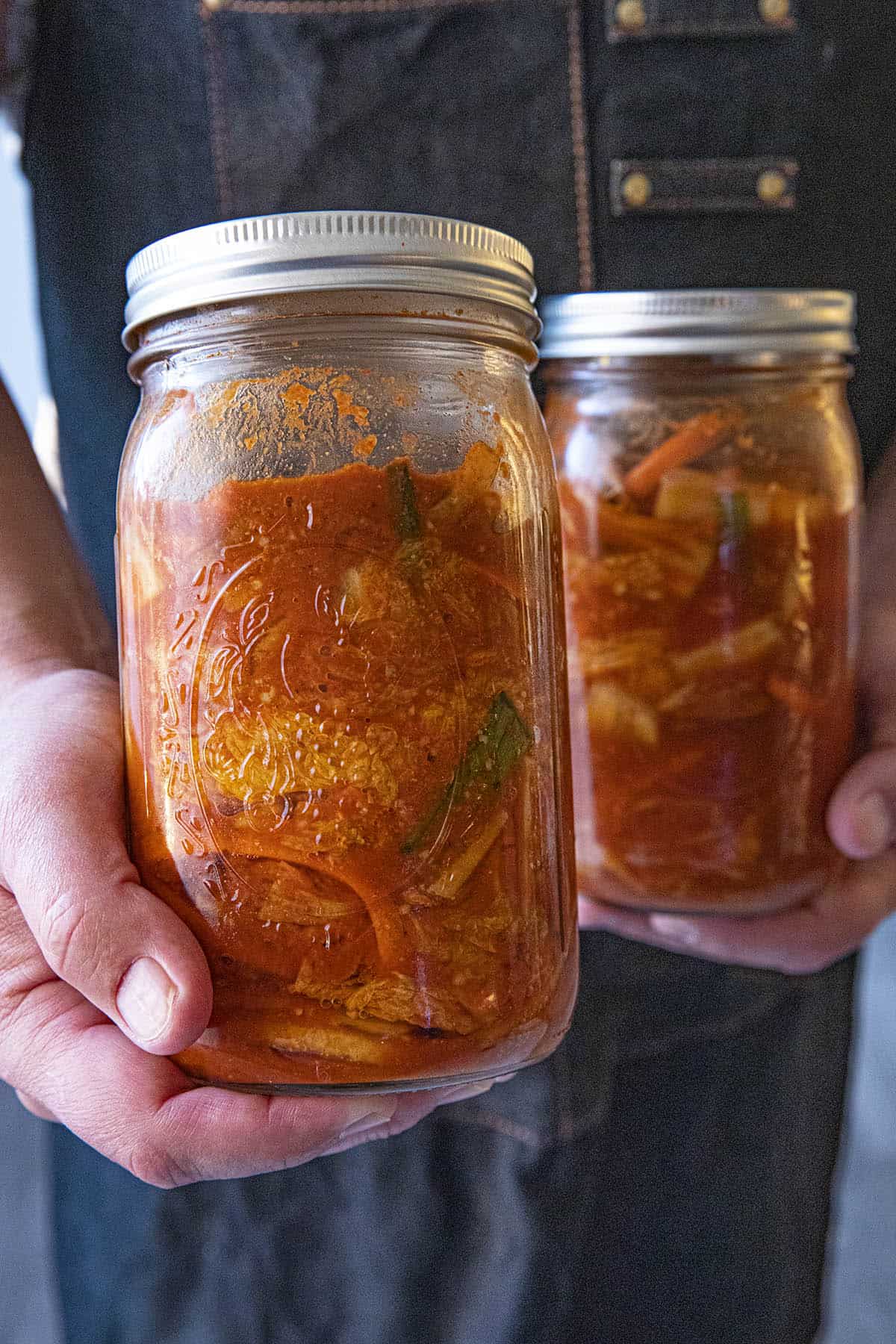
Recipe Tips & Notes
Umami Swaps. More traditional kimchi recipes use salted shrimp (along with fish sauce) to achieve that wonderful umami it is known for, but it can be hard to find.
You can use other ingredients, such as extra fish sauce, shrimp paste, dried shrimp, seaweed, anchovies, dried fish, soy sauce, or miso paste. I enjoy a combo of shrimp paste, fish sauce and miso, all of which I always have on hand for other recipes.
Kimchi Sauce Swaps. Gochugaru is pretty essential, but you can use gochujang instead, which is a Korean fermented chili paste. Try it with both.
Fermentation Times. Fermentation times can vary, depending on temperatures and ingredients. You can ferment longer if you'd like, but it is best to judge by smell and flavor.
The kimchi will grow more sour as it ferments, which some people prefer. Smell and taste after a day or two, then transfer to the refrigerator where it will continue the fermentation process more slowly.
Go Beyond Cabbage Kimchi. Napa cabbage is more commonly used to make kimchi, and is what most people associate with it. However, you can make kimchi with any vegetable, such as cucumber kimchi, which is another popular version, radish kimchi or mustard greens and others.
Try it with some of your favorite vegetables, or a combination of them.
What to Make with Kimchi? Kimchi Recipes
You can simply serve a 1/4 cup to a 1/2 cup as a simple side dish vegetable or snack. Or, swirl it into soups and stews, particularly stir fries where it really shines.
You can also make many dishes with spicy kimchi. Kimchi Fried Rice is hugely popular, and quite delicious, as is Kimchi Stew (kimchi jjigae), and I love to eat Kimchi Ramen.
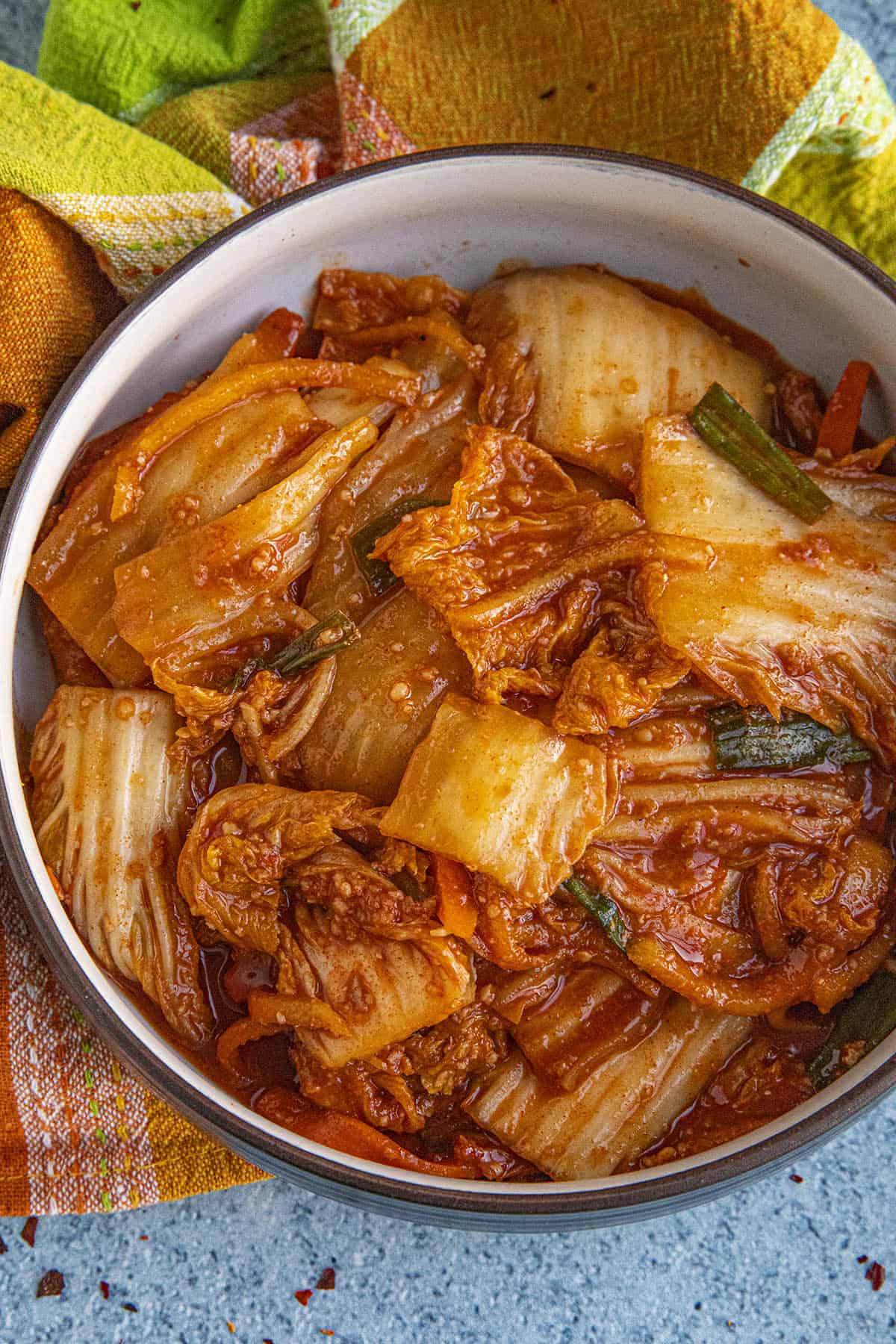
Storage Information
Homemade kimchi will last 6-8 months or longer in the refrigerator in a sealed container. You can use it in so many dishes.
It typically will last 1 week or so outside of the refrigerator, so it is best to keep it refrigerated.
That's it, my friends. I hope you enjoy my kimchi recipe. Let me know if you make it. I'd love to hear how it turned out for you. Keep it spicy! Extra spicy for me, please! I love kimchi.
Try Some of My Other Popular Recipes
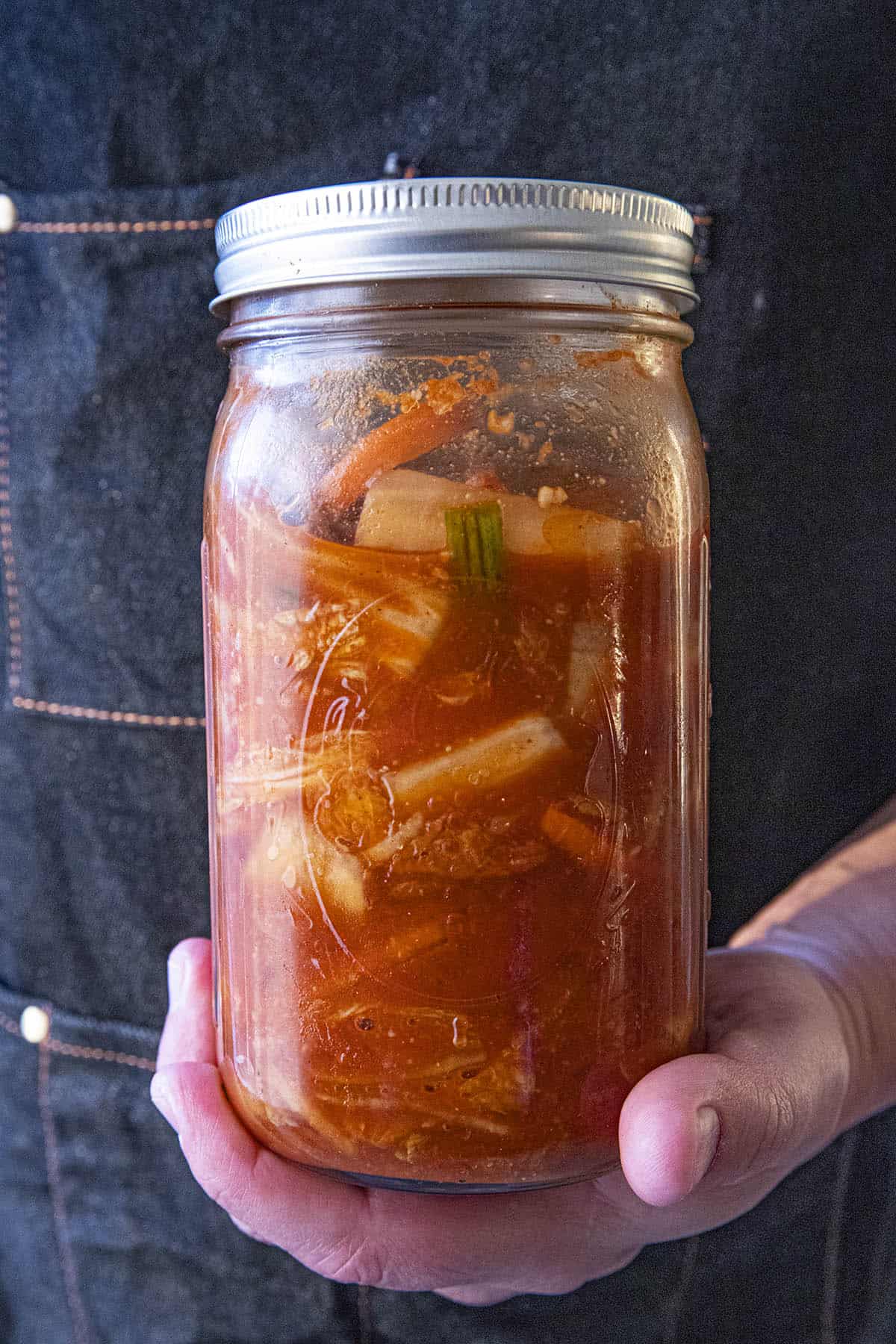
Got any questions? Ask away! I’m happy to help. If you enjoy this recipe, I hope you’ll leave a comment with some STARS. Also, please share it on social media. Don’t forget to tag us at #ChiliPepperMadness. I’ll be sure to share! Thanks! — Mike H.
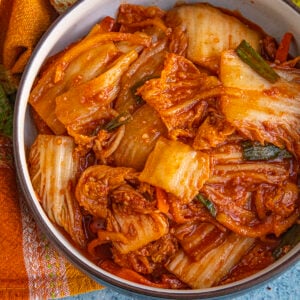
Spicy Kimchi Recipe (How to Make Kimchi)
Ingredients
FOR THE CABBAGE BRINE
- 2 quarts unchlorinated water filtered or bottled water are good
- ½ cup kosher salt or sea salt
- 1 head about 3 pounds; 1.3kg Napa cabbage
TO MAKE THE KIMCHI
- 1 carrot sliced into matchsticks
- 1 bunch scallions end trimmed, cut into ½ inch pieces
- 1 small daikon radish or turnip peeled, sliced into matchsticks
- ½ Asian pear peeled, sliced into matchsticks
- 6 garlic cloves chopped
- 2 tablespoons fresh grated ginger
- 3 tablespoons glutinous rice flour
- 1 cup gochugaru Korean chili flakes
- 1/2 cup fish sauce
- 3 tablespoons salted shrimp saeujeot, minced – as an alternative, use 1.5 tablespoons shrimp paste, or 3 tablespoons chopped dried shrimp (soaked), or 2 tablespoons miso paste
- 2 tablespoons miso paste red or white – optional, for extra umami flavor
Instructions
BRINE THE CABBAGE
- Whisk together the unchlorinated cold water and sprinkle salt in a large bowl.
- Slice off the root end of the cabbage. Slice the cabbage into quarters and submerge them in the brine. Use a plate or other small weights to keep the cabbage completely submerged.
- Set aside for 8-12 hours at room temperature.
- Set the cabbage into a colander and drain the brine. Rinse the cabbage and squeeze out excess water using your hands. Chop the cabbage into 1 inch pieces (if desired, or leave the pieces whole).
MAKE THE KIMCHI
- Add the cabbage to a large bowl along with the carrot, scallions, radish or turnip, Asian pear, garlic and ginger. Toss to combine.
- Add the rice flour and 1 cup water to a sauce pan. Heat to a simmer, then whisk for 3-4 minutes until smooth and the mixture forms a smooth, loose paste.
- Remove from heat and stir in the gochugaru. The chili flakes will bloom as the mixture cools.
- Stir in the fish sauce, salted shrimp, and miso paste (or your other umami alternatives).
- Pour the mixture into the cabbage and vegetables. With your hands, rub the gochugaru mixture into the vegetables, covering them as completely as possible. Be thorough. Really get in there with your hands!
- Taste and adjust for salt or any other desired seasonings.
- Pack the kimchi into a large mason jar (or several). You can use other vessels, like a fermentation crock. Press the contents down and weigh it down with glass fermentation weights (or use a plastic bag filled with water).
- Cover with a fermentation airlock lid, or use fermentation membranes (see notes). If you don’t have such lid options, use a 2-piece lid, but don’t screw it down, just set it on top. This is to allow any gases to escape while fermenting.
- Set aside away from any sunlit areas and ferment for 1-3 days at room temperature (you CAN ferment longer if you’d like – see RECIPE NOTES on fermentation times). Moisture should release from the kimchi, so press the kimchi down if needed to keep it below the liquid. Gases should escape via the fermentation membrane, or just loosen the lid to let any gas build up out.
- Set into the refrigerator and let sit for 1 week to let the flavors mingle. You can enjoy it right away, but it is better to wait. The fermenting kimchi will continue to ferment slowly in the fridge.
- Use as desired.
Notes
Nutrition Information
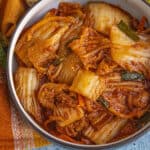



MB says
Can you use Korean Fermented Sauce (Salted Shrimp Sauce)?
Mike Hultquist says
You can use it for flavoring, though I have not tried it. I'd love to hear how it turns out if you use it.
Michael Brown says
Having a hard time finding 3 tablespoons salted shrimp saeujeot, minced
Mike Hultquist says
I'm sure you're salted fish sauce will be fine, or as an alternative, use 1.5 tablespoons shrimp paste, or 3 tablespoons chopped dried shrimp (soaked), or 2 tablespoons miso paste.
tuxthelux says
wow, it turned out splendidly! I lived with a Korean woman 40 yrs ago and she taught me to make Kimchi, fern and a few other dishes. After all this time and the fact that I couldn't find any decent Kimchi anymore, I tried it again. Thank you so much.
Mike Hultquist says
Nice! Glad to help!
Emo says
I’ve been making Kimchi for quite a few years. I have tried the soak in brine method (as you used) and the dipped in brine and then salt rub method (traditional) on the cabbage. I like my kimchi a bit crunchy so your method fits well with that. I didn’t soak it for quite as long as you but It’s a great recipe. Thanks.
Darkrosesus says
Hi Mike, can this be frozen? I’m about to make some but it’s more than I would be able to eat seeing as I’m the only person who would be eating it due to my husband not being a spicy food lover.
Mike Hultquist says
You can freeze it, yes, though it's fermented and will last a long time in the fridge in a sealed container.
William Falin says
I all ways liked the taste of pickles and fermented food,I
have been eating mashed potatoes and added sour krout.
Patricia A Dufour says
what umami can I use besides anything that is fish related?
Mike Hultquist says
Mushrooms are GREAT here.
Lauren says
How much rice flour into the one cup of water to make the paste?
Looks delicious!
Mike Hultquist says
Lauren, I used 3 tablespoons. All of the exact measurements are in the recipe card at the bottom of the post. So good!!
Nathan Yuma says
When substituting gochujang paste for the 1 cup of gochugaru how much would you recommend?
Mike Hultquist says
Nathan, use a 2-3 tablespoons.
Jon Menke says
turned out just wonderful for the 4 th time I multiple by 4 to fill 1/2 gallon jar.
Mike Hultquist says
Excellent! Thanks for sharing, Jon!
Nicolaj says
How much is 16 servings here? I don't know how to translate that into say liters or quarts (whatever you prefer).
Michael Hultquist - Chili Pepper Madness says
You'll get at least 2 packed quarts. Enjoy.
Laura Kim says
Sounds delicious! I have questions how is the bacteria of miso and kimchi working together? Is it OK? And also is it going to be miso flavour kimchi? I want to make it for my people who are vegan. Thanks:)
Michael Hultquist - Chili Pepper Madness says
Thanks, Laura. You'll get more of the gochujang flavor than miso, but overall, the flavor expression is outstanding. For me, at least! I hope it is enjoyed!
Sheldon lawrence says
do you have any comments , recipes for RELISH? IM using red onions, salt, sugar, garlic. red pepper flakes (USA) vinegar. maybe a carrot or bell pepper. it seems that relish, kimchi, chili recipes are all great. hard to choose which i like better. thoughts?
shel lawrence
Michael Hultquist - Chili Pepper Madness says
Shel, I have a few different recipes for relish on the site. Try this Hot Pepper Relish Recipe: https://www.chilipeppermadness.com/chili-pepper-recipes/sauces/hot-pepper-relish/. I love this one. Or, try this Tomato Relish: https://www.chilipeppermadness.com/recipes/green-tomato-relish/. I hope this helps! Cheers!
Tina Wilcox says
I have not made this yet, but will be making it this week! I have been looking for a Kimchi recipe! Thanks
Michael Hultquist - Chili Pepper Madness says
Enjoy, Tina. Such an enjoyable recipe. So many ways to use kimchi!